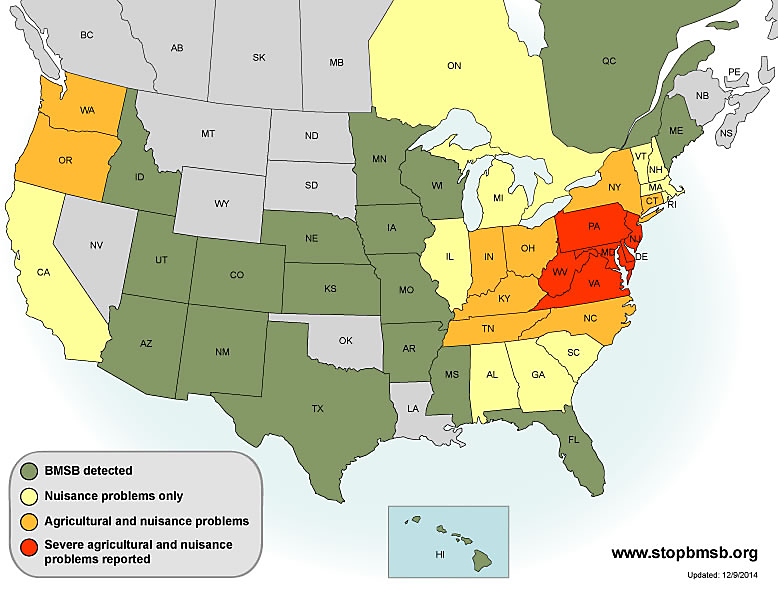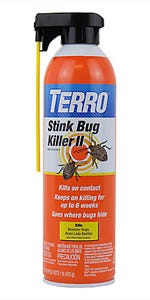Brown Marmorated Stink Bugs

Brown marmorated stink bugs are merely an aggravation for most homeowners. These pests don’t sting or bite, but they are aptly named. When frightened, crushed, squashed or vacuumed up, stink bugs emit a putrid smell from scent glands located on their underbellies.
For farmers, however, these smelly bugs present a much bigger problem. A nuisance to fruit, vegetable and farm crops, stink bugs prey on crops like raspberries, tomatoes, peaches and other fruits, sucking out the juices. The USDA estimates that stink bugs caused as much as $37 million in damage to U.S. apple orchards in one year alone.
Appearance
Part of the insect family called Pentatomids, there are several different species of stink bugs across the United States. The most common is the brown marmorated stink bug, which can be spotted by these distinguishing characteristics:
- Up to 1" in length with broad bodies
- Six legs and wings
- Antennae with white bands
- Speckled brown and gray colored bodies
- Large triangle shape on back called scutellum
- Sucking mouth-parts
- Set of foul-smelling defensive glands underneath their bodies

Habitat
Stink bugs like to hang out together. In warm weather, adult stink bugs cram themselves together on plants, sidewalks and building structures. By fall, they begin searching for warm overwintering sites, entering buildings through cracks, open doors and windows, and even hitching a ride on pets. When stink bugs find a suitable place to spend the winter, they release an aggregation pheromone to share the news.
Geography
The stink bug is an agricultural pest native to Asia. Since they were first spotted in Allentown, PA in the late 1990's, stink bug invasions have been on a steady rise in the U.S. Stink bugs have officially invaded 42 states, from as far west as California to as far north as Maine.
Reproduction

In spring, the adult stink bug lays organized clusters of 20 to 30 eggs on the underside of leaves. The eggs hatch into small red and black nymphs that go through five molts, or immature stages, growing from less than 1/16" to about 1/2" through summer.
Depending on temperature, the stink bug life cycle is completed in one year. The species typically have a single generation per year, although warm weather conditions can allow for two or three generations to develop.
Diet
Stink bugs feed on a wide variety of plants. Around the home, stink bugs can be found on ornamental plants and in the garden. Commercially, stink bugs have caused severe loss in apple and peach orchards, as well as blackberry, sweet corn, field corn, and soybeans.
Control Options

When it comes to stink bug elimination, habitat control is an important step. Defend yourself against pungent perpetrators by sealing cracks around doors and windows with caulk and apply weather stripping under exterior doors. Cover crawlspaces and attic vents with screens, and repair or replace any damaged window or door screens. Keeping your grass cut low and eliminating weeds can make your lawn and garden much less inviting to stink bugs.
If smelly stink bugs have invaded your home, TERRO® has you covered with two effective control options to quickly kill on contact.
TERRO® Stink Bug Killer Aerosol Spray can be used to treat broad areas or cracks and crevices in and around homes, using the can’s two-way spray nozzle. Apply to areas where stink bugs crawl and hide, especially on window screens and frames; around doors and windows; and around porches, patios and garages.
This TERRO® Stink Bug control product is non-staining, odorless and effective against other unwanted pests, including boxelder bugs, Asian lady beetles, ants and crickets.
Bibliography
http://www.ipm.ucdavis.edu/PMG/GARDEN/VEGES/PESTS/stinkbug.html
http://entomology.osu.edu/welty/ppt%20pdf/TomatoStinkBugJan03R.pdf
http://www.cincinnati.com/story/money/2014/10/13/stinkbugs-cincinnati-kentucky/17214889/
http://www.stopbmsb.org/where-is-bmsb/
